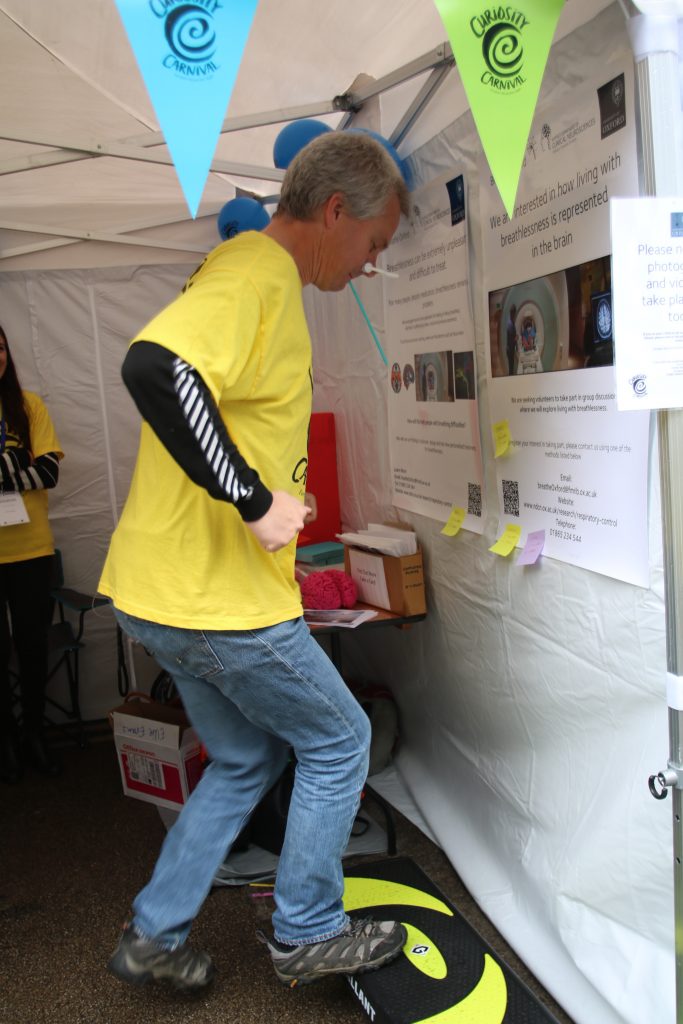Curious about breath at the Oxford Curiosity Carnival
Music therapist and writer Kate Binnie writes:
Friday 29th September saw Oxford’s City Centre transformed by the Curiosity Carnival. This University-organised event sought to bring together researchers across fields of study to share knowledge, answer questions, and interact in creative ways with the public in order to stimulate curiosity and dialogue (which is of course where all research journeys begin…)
The Breathe Oxford team braved the moody weather and set up stall in a gazebo on Broad Street to share their research on the brain, anxiety and breathlessness. (picture of gazebo on street). Neuroscientist and Life of Breath collaborator Professor Kyle Pattinson brought his portable step, a nose clip, some drinking straws, a couple of camping chairs and his team of researchers who were on hand to talk about their research throughout the day. The idea was to convince people of all ages to take a 30 second step test, first without accessories but the second time with their breathing restricted with the nose clip breathing only through the straw. Participants were offered a delicious slice of brain cake as a reward for taking part. The team wanted to show people what it might be like to live with breathlessness, and informally gather data about their impressions of exercising with impaired ability to breathe.
Restricting, Frightening, panicky, clumsy, had to stop, horrible were some of the comments from those who took part. After this, they were offered the chance to come with me into a corner of the tent for a short breath re-training. We demonstrated how the mindful breath-regulation techniques that I use clinically with patients with severe breathlessness could change the way breathing felt: Peaceful, calming, relaxing, in a bubble, safe, in control were some of people’s thoughts. Interestingly, each practice was typically only 3 minutes long, and took place in the hubbub of the carnival and next to the competitive pounding of the step-test participants, revealing that even in such a stimulating environment it’s possible to focus the mind, regulate the breath and shift affective responses.

It was fascinating to talk to people about their relationship with their breath, whether living with asthma or COPD or prone to anxiety or panic attacks. It seemed from my interactions (with young girls of 18 to older men in their 70s) that in opening up this conversation about breathing, anxiety, the brain and breathlessness, we were scratching the surface of a need for information about this most primal and central experience of being alive. When breath is compromised, so is life. And this can be due to an underlying pathology like asthma and/or the body’s response to anxiety, especially when the brain is wired to “trip” from past traumatic experiences thus setting up a cycle of negative expectations and body-mind interactions. Unlike other vital functions of the body – e.g. our heartbeat or the flow of hormones regulating digestion, sleep and mood – we can consciously tune into and regulate our breathing, manipulating the rest of the nervous system and the way we feel. What I found inspiring was the way in which people seemed so hungry to understand and discuss this process, sharing their often very personal experiences, fears and vulnerabilities around the topic.
It was a huge pleasure and privilege to share some of the ancient techniques from the traditions of yoga and mindfulness with curious people off the street. I certainly learned a lot and am delighted if any of them came away with a mini-tool for self-regulation or an interest in finding out more about their breathing and their brain.




